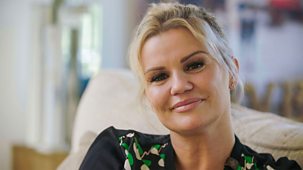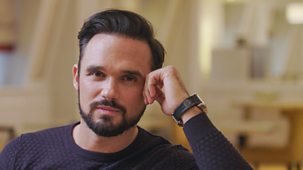
Series 1: Episode 3
As austerity bit in 2010, the nation’s penchant for sparkle was undimmed. Luckily, there was a big, shiny bash on the horizon. In April 2011, William and Kate tied the knot. Far from a dusty ceremonial affair, these nuptials were a star-studded bash with celebrity front and centre. Where once celebrities capitalised on their links to royalty, now royalty was making the most of its celebrity connections. Twelve years after their own wedding, Posh and Becks found themselves rubbing shoulders with royalty in Westminster Abbey. This was a royal wedding for the modern era; a digital event watched by billions of people around the world on dedicated YouTube channels and Twitter feeds.\n \nA digital revolution was taking place, and celebrities were at its forefront. The old tabloid machinery was losing power, and the Milly Dowler scandal was another blow to an already declining industry. Celebrities who had relied on print media were making the move to the digital press, and those, like Katie Price, who were late to the online party, were coming unstuck.\n \nWhile some were slow to sidestep the traditional tabloid machinery, others were embracing the digital domain. On series 7 of X Factor, the people behind the scenes began to notice a digital buzz around one of the acts, and the One Direction phenomenon was born. The band came third, but Simon Cowell signed them anyway, sending them to the top of the charts within weeks. Using social media to reach every corner of the globe, a super-tribe formed around One Direction. They became the best-selling band of 2011 and swiftly broke America.\n \nWhile Simon Cowell was cashing his 1D cheques, TOWIE launched careers like Amy Childs’, and all things Essex were beamed into living rooms across Britain, soon followed by rival show featuring Spencer Matthews and Chelsea’s social set. ‘Structured reality’ shows dominated the younger demographic - all via social media.\n \nBut there was a different form of TV celebrity in the making. What had started off as a repository for quirky cat videos now saw content creators emerge from their day jobs to become celebrity YouTubers like Dan Middleton and Louise Pentland, who have millions of followers and, in some cases, invitations to meet the Pope. Yet the irony was that no-one apart from the YouTubers and their followers knew who they were – this was the most significant generational split since rock 'n' roll, and these people were sidestepping the machinery which lined the traditional routes to fame.\n \nThis subversion of normal routes of communication wasn’t confined to bedroom broadcasters. Trump followed in Obama’s footsteps and grasped the digital tools on hand, but went one step further - distilling entire political credos into short, blunt statements.\n \nBy 2014, narcissism was the most powerful force in fame. Ten years earlier, Paris Hilton pioneered the selfie, calling it the 21st-century autograph. The selfie became a key focus for the famous, and at the Oscars, Ellen DeGeneres took the most famous selfie of all time. \n \nThe selfie and the image-driven culture surrounding it became so important, it demanded the creation of its own platform. That's how Instagram was born. The ultimate Instagram endorser, Kim Kardashian, has with her sisters a following of more than half a billion and can make $1million from a single post. She’s so successful, she has even redefined how women look, with an explosion in demand for ‘butt-lift’ surgery. She is a true influencer, and around the world, ordinary people like Jamie Genevieve began to use the same techniques to propel themselves to fame and their followers to the shops. \n \nThe celebrity landscape had been transformed by digital technology. The new celebrities had direct conduits to their fans, which elevated them above the analogue stars, who relied on PR, producers, journalists for their profile. This directness was enormously profitable, but vicious messages could flow the other way, as contact with their fans also meant the fans had contact with them. The instant communication of platforms like Twitter brought great power, but the still unresolved question was how that power would be used.
Source: BBC 2
Most recent episodes of Celebrity: A 21st-Century Story
Celebrity: A 21st-century Story
Series 1: Episode 4
After a tumultuous 15 years for celebrities and the people who profit from them, by 2016 it seemed the celebrities were taking over. Charting the last five tumultuous years, thi ...
28-01-2021
BBC 2
Celebrity: A 21st-century Story
Series 1: Episode 3
As austerity bit in 2010, the nation’s penchant for sparkle was undimmed. Luckily, there was a big, shiny bash on the horizon. In April 2011, William and Kate tied the kno ...
21-01-2021
BBC 2
Celebrity: A 21st-century Story
Series 1: Episode 2
Charting fame in the late noughties, the second episode looks at the ways in which different groups cashed in on what had become a worldwide obsession with fame and the ways in ...
14-01-2021
BBC 2
Celebrity: A 21st-century Story
Series 1: Episode 1
Celebrity: A 21st-Century Story is a four-part history series charting the explosion in celebrity culture over the last two decades.\n \nThe world of celebrity has been transfor ...
07-01-2021
BBC 2
Most popular episodes of Celebrity: A 21st-Century Story
Celebrity: A 21st-century Story
Series 1: Episode 4
After a tumultuous 15 years for celebrities and the people who profit from them, by 2016 it seemed the celebrities were taking over. Charting the last five tumultuous years, thi ...
28-01-2021
BBC 2
Celebrity: A 21st-century Story
Series 1: Episode 1
Celebrity: A 21st-Century Story is a four-part history series charting the explosion in celebrity culture over the last two decades.\n \nThe world of celebrity has been transfor ...
07-01-2021
BBC 2
Celebrity: A 21st-century Story
Series 1: Episode 2
Charting fame in the late noughties, the second episode looks at the ways in which different groups cashed in on what had become a worldwide obsession with fame and the ways in ...
14-01-2021
BBC 2
Celebrity: A 21st-century Story
Series 1: Episode 3
As austerity bit in 2010, the nation’s penchant for sparkle was undimmed. Luckily, there was a big, shiny bash on the horizon. In April 2011, William and Kate tied the kno ...
21-01-2021
BBC 2




